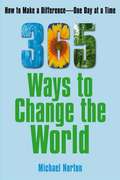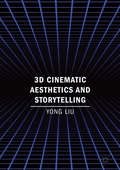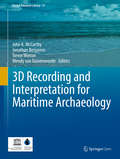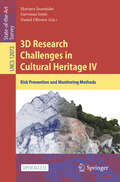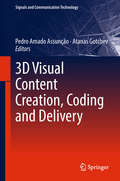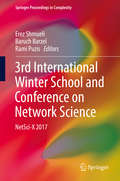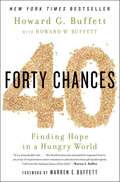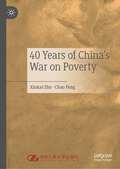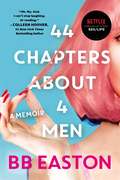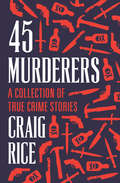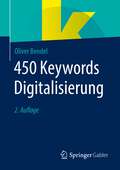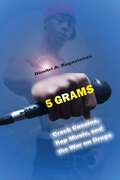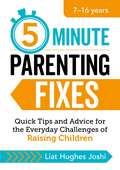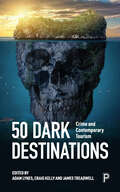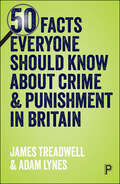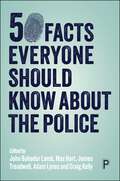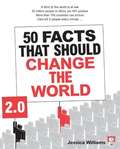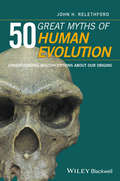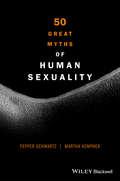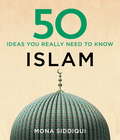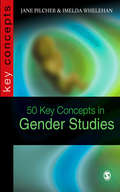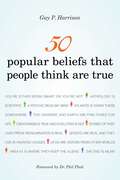- Table View
- List View
365 Ways to Change the World: How to Make a Difference... One Day at a Time
by Michael NortonYou want to make a difference in the world, but don't know where to begin. Now you can. Here is just the guide to lots of exciting ways that are more personal and fun than merely writing a check. For every day of the year, 365 Ways to Change the World is packed with information and ideas that don't take a lot of special skills to put into action, but will achieve something positive: Observe a "Buy Nothing Day" Plant a "peace pole" Sew a panel for an AIDS memorial quilt Collect rainwater to water your plants The suggestions cover twelve important areas in which you can influence change, including in your local community, as a consumer, making a cultural contribution, and addressing problems such as the environment, health, and human rights. You can go through the book day by day or use the index to flip to the issues that concern you most; to help you take action, a complementary website links straight to many of the sources listed in the book. Great to give as well as to keep, this is an inspiring, practical resource for making the world a better place -- one day at a time.
38 Nooses: Lincoln, Little Crow, and the Beginning of the Frontier's End
by Scott W. BergIn August 1862, after decades of broken treaties, increasing hardship, and relentless encroachment on their lands, a group of Dakota warriors convened a council at the tepee of their leader, Little Crow. Knowing the strength and resilience of the young American nation, Little Crow counseled caution, but anger won the day. Forced to either lead his warriors in a war he knew they could not win or leave them to their fates, he declared, "[Little Crow] is not a coward: he will die with you." So began six weeks of intense conflict along the Minnesota frontier as the Dakotas clashed with settlers and federal troops, all the while searching for allies in their struggle. Once the uprising was smashed and the Dakotas captured, a military commission was convened, which quickly found more than three hundred Indians guilty of murder. President Lincoln, embroiled in the most devastating period of the Civil War, personally intervened in order to spare the lives of 265 of the condemned men, but the toll on the Dakota nation was still staggering: a way of life destroyed, a tribe forcibly relocated to barren and unfamiliar territory, and 38 Dakota warriors hanged--the largest government-sanctioned execution in American history. Scott W. Berg recounts the conflict through the stories of several remarkable characters, including Little Crow, who foresaw how ruinous the conflict would be for his tribe; Sarah Wakefield, who had been captured by the Dakotas, then vilified as an "Indian lover" when she defended them; Minnesota bishop Henry Benjamin Whipple, who was a tireless advocate for the Indians' cause; and Lincoln, who transcended his own family history to pursue justice.Written with uncommon immediacy and insight, 38 Nooses details these events within the larger context of the Civil War, the history of the Dakota people, and the subsequent United States-Indian wars. It is a revelation of an overlooked but seminal moment in American history.
3D Cinematic Aesthetics and Storytelling
by Yong LiuThis book argues that 3D films are becoming more sophisticated in utilising stereoscopic effects for storytelling purposes. Since Avatar (2009), we have seen a 3D revival marked by its integration with new digital technologies. With this book, the author goes beyond exploring 3D’s spectacular graphics and considers how 3D can be used to enhance visual storytelling. The chapters include visual comparisons between 2D and 3D to highlight their respective narrative features; an examination of the narrative tropes and techniques used by contemporary 3D filmmakers; and a discussion of the narrative implications brought by the coexistence of flatness and depth in 3D visuality. In demonstrating 3D cinematic aesthetics and storytelling, Yong Liu analyses popular films such as Hugo (2011), Life of Pi (2012), Gravity (2013), Star Trek Into Darkness (2013, and The Great Gatsby (2013). The book is an investigation into contemporary forms of stereoscopic storytelling derived from a unique, long-existing mode of cinematic illusions.
3D Printing for Development in the Global South: The 3D4D Challenge
by Thomas Birtchnell William HoyleWill 3D printers become as commonplace as mobile phones in the megacities or the backwaters of the Global South? Thomas Birtchnell and William Hoyle assess the development potential of this new technique for producing three-dimensional objects, which resembles the way a paper printer produces pages of text. Will 3D printing for development become a key strategy for community action against enduring material poverty? Birtchnell and Hoyle consider this question through a centrepiece case study on the UK charity techfortrade's 3D4D Challenge.
3D Recording and Interpretation for Maritime Archaeology (Coastal Research Library #31)
by Jonathan Benjamin John K. McCarthy Trevor Winton Wendy Van DuivenvoordeThis open access peer-reviewed volume was inspired by the UNESCO UNITWIN Network for Underwater Archaeology International Workshop held at Flinders University, Adelaide, Australia in November 2016. Content is based on, but not limited to, the work presented at the workshop which was dedicated to 3D recording and interpretation for maritime archaeology. The volume consists of contributions from leading international experts as well as up-and-coming early career researchers from around the globe. The content of the book includes recording and analysis of maritime archaeology through emerging technologies, including both practical and theoretical contributions. Topics include photogrammetric recording, laser scanning, marine geophysical 3D survey techniques, virtual reality, 3D modelling and reconstruction, data integration and Geographic Information Systems. The principal incentive for this publication is the ongoing rapid shift in the methodologies of maritime archaeology within recent years and a marked increase in the use of 3D and digital approaches. This convergence of digital technologies such as underwater photography and photogrammetry, 3D sonar, 3D virtual reality, and 3D printing has highlighted a pressing need for these new methodologies to be considered together, both in terms of defining the state-of-the-art and for consideration of future directions. As a scholarly publication, the audience for the book includes students and researchers, as well as professionals working in various aspects of archaeology, heritage management, education, museums, and public policy. It will be of special interest to those working in the field of coastal cultural resource management and underwater archaeology but will also be of broader interest to anyone interested in archaeology and to those in other disciplines who are now engaging with 3D recording and visualization.
3D Research Challenges in Cultural Heritage IV: Risk Prevention and Monitoring Methods (Lecture Notes in Computer Science #13577)
by Marinos Ioannides Daniel Oliveira Giovanni IssiniThis open access book presents a collection of papers focusing on a range of digital technologies and their use in the protection and restoration of cultural heritage. Digital tools - from 3D scanning and photogrammetry to Heritage Building Information Modeling (HBIM), Digital Twins, and Extended Reality (XR) - are transforming the way we understand and care for tangible heritage. These technologies are applied to both record the physical form and material conditions of a site and to permit simulations of deterioration, design interventions, and careful reconstruction. A central theme of this volume is post-disaster restoration and how the scientific and technical aspects of restoration can be made accessible to a broader audience through innovative visualizations, interactive platforms and storytelling. Digital tools should not only serve experts but also allow the public to participate both on-site and remotely via the web. This book advocates a holistic approach to heritage management, combining cutting-edge technology with local knowledge, risk analysis with creative reuse, and positioning the act of restoration as a bridge connecting the past, present and future.
3D Visual Content Creation, Coding and Delivery (Signals and Communication Technology)
by Pedro Amado Assunção Atanas GotchevThis book covers the different aspects of modern 3D multimedia technologies by addressing several elements of 3D visual communications systems, using diverse content formats, such as stereo video, video-plus-depth and multiview, and coding schemes for delivery over networks. It also presents the latest advances and research results in regards to objective and subjective quality evaluation of 3D visual content, extending the human factors affecting the perception of quality to emotional states. The contributors describe technological developments in 3D visual communications, with particular emphasis on state-of-the-art advances in acquisition of 3D visual scenes and emerging 3D visual representation formats, such as: multi-view plus depth and light field;evolution to freeview and light-field representation;compression methods and robust delivery systems; andcoding and delivery over various channels. Simulation tools, testbeds and datasets that are useful for advanced research and experimental studies in the field of 3D multimedia delivery services and applications are covered. The international group of contributors also explore the research problems and challenges in the field of immersive visual communications, in order to identify research directions with substantial economic and social impact. 3D Visual Content Creation, Coding and Delivery provides valuable information to engineers and computer scientists developing novel products and services with emerging 3D multimedia technologies, by discussing the advantages and current limitations that need to be addressed in order to develop their products further. It will also be of interest to students and researchers in the field of multimedia services and applications, who are particularly interested in advances bringing significant potential impact on future technological developments.
3rd International Winter School and Conference on Network Science: NetSci-X 2017 (Springer Proceedings in Complexity)
by Erez Shmueli Baruch Barzel Rami PuzisThis book contains original research chapters related to the interdisciplinary field of complex networks spanning biological and environmental networks, social, technological, and economic networks. Many natural phenomena can be modeled as networks where nodes are the primitive compounds and links represent their interactions, similarities, or distances of sorts. Complex networks have an enormous impact on research in various fields like biology, social sciences, engineering, and cyber-security to name a few. The topology of a network often encompasses important information on the functionality and dynamics of the system or the phenomenon it represents. Network science is an emerging interdisciplinary discipline that provides tools and insights to researchers in a variety of domains. NetSci-X is the central winter conference within the field and brings together leading researchers and innovators to connect, meet, and establish interdisciplinary channels for collaboration. It is the largest and best known event in the area of network science. This text demonstrates how ideas formulated by authors with different backgrounds are transformed into models, methods, and algorithms that are used to study complex systems across different domains and will appeal to researchers and students within in the field.
40 Chances
by Howard G BuffettIf you had the resources to accomplish something great in the world, what would you do?Legendary investor Warren Buffett posed this challenge to his son in 2006, when he announced he was leaving the bulk of his fortune to philanthropy. Howard G. Buffett set out to help the most vulnerable people on earth--nearly a billion individuals who lack basic food security. And Howard has given himself a deadline: 40 years to put more than $3 billion to work on this challenge. Each of us has about 40 chances to accomplish our goals in life. This is a lesson Howard learned through his passion for farming. All farmers can expect to have about 40 growing seasons, giving them just 40 chances to improve on every harvest. This applies to all of us, however, because we all have about 40 productive years to do the best job we can, whatever our passions may be. 40 Chances: Finding Hope in a Hungry World is a new book that captures Howard's journey. Beginning with his love for farming, we join him around the world as he seeks out new approaches to ease the suffering of so many. It is told in a unique format: 40 stories that will provide readers a compelling look at Howard's lessons learned, ranging from his own backyard to some of the most difficult and dangerous places on Earth.
40 Years of China's War on Poverty
by Xinkai Zhu Chao PengChina's anti-poverty campaign has liberated hundreds of millions of citizens from absolute poverty, offering a compelling model for other developing countries around the world. This book demonstrates the path of China’s poverty alleviation and explores the approach and the theory underlying the country’s experience. The authors elucidate four important stages of poverty alleviation in China. They further investigate how the administration has balanced economic growth, regional development and the protection of ecosystem and cultural and heritage sites during China's remarkable transformation. As China’s development experience have extended the theory of international poverty alleviation, this book should provide valuable insights and offer enlightenment to global scholars, NGOs and governments of other developing countries.
44 Chapters About 4 Men
by BB EastonOne woman's secret journal completely changes her marriage in this hilarious and biting memoir -- soon to be a Netflix Original Series.School psychologists aren't supposed to write books about sex. Doing so would be considered "unethical" and "a fireable offense." Lucky for you, ethics was never my strong suit.44 Chapters About 4 Men is a laugh-out-loud funny and brutally honest look at female sexuality, as told through the razor-sharp lens of domesticated bad girl BB Easton. No one and nothing is off limits as BB revisits the ex-boyfriends -- a sadistic tattoo artist, a punk rock parolee, and a heavy metal bass player -- that led her to finally find true love with a straight-laced, drop-dead-gorgeous...accountant.After settling down and starting a family with her perfectly vanilla "husbot," Ken, BB finds herself longing for the reckless passion she had in her youth. She begins to write about these escapades in a secret journal, just for fun, but when Ken starts to act out the words on the pages, BB realizes that she might have stumbled upon the holy grail of behavior modification techniques. The psychological dance that ensues is nothing short of hilarious as BB wields her journal like a blowtorch, trying to light a fire under her cold, distant partner. Sometimes it works, sometimes it doesn't, but in the end, BB learns that the man she was trying so hard to change was perfect for her all along.
45 Murderers: A Collection of True Crime Stories
by Craig RiceFrom Hollywood’s Black Dahlia to the Arkansas Bluebeard: an anthology of true crime profiles by “the grand dame of mystery” (Ed Gorman). Whether venturing into a blood-spattered farm in Texas, down a lonely mountain road in Alabama, or into the deceptively sunny Ohio suburbs, acclaimed mystery writer Craig Rice lends her hard-boiled style and a wicked irony to this gallery of real-life murders. Among them . . . A saintly middle-aged widow bludgeoned to death in her New Jersey home; the headless torsos of two women found floating in the Lake of the Ozarks; a New Year’s fire in Pennsylvania set to cover the traces of a more ghastly crime; a traveling evangelist on a divine mission blown to bits in Berkley; an aspiring starlet tortured, bisected, and dumped in a vacant LA lot; and a New York couple poisoned to death by the mysterious “Veiled Murderess,” a convicted killer who never revealed her motives—or her true identity. Culled from Rice’s work as a crime reporter, “the stories in 45 Murderers have withstood time” as a century-spanning, cross-country tour of the sinister underbelly of the American Dream (Jeffrey Marks, author of Who Was That Lady?).
450 Keywords Digitalisierung
by Oliver BendelVon „Big Data“ über die „Künstliche Intelligenz“ bis hin zur „Sozialen Robotik“: Im Kontext der Digitalisierung gibt es unzählige Fachtermini. Das vorliegende Nachschlagewerk ist für alle geeignet, die einen schnellen Einstieg in das Gebiet der Digitalisierung suchen und sich für Fragen der Ethik interessieren. In 350 übersichtlichen Beiträgen werden die Grundlagen und Entwicklungen leicht verständlich erläutert.
5 Grams: Crack Cocaine, Rap Music, and the War on Drugs (Alternative Criminology #15)
by Dimitri A. BogazianosIn 2010, President Barack Obama signed a law repealing one of the most controversial policies in American criminal justice history: the one hundred to one sentencing disparity between crack cocaine and powder whereby someone convicted of “simply” possessing five grams of crack—the equivalent of a few sugar packets—had been required by law to serve no less than five years in prison. In this highly original work, Dimitri A. Bogazianos draws on various sources to examine the profound symbolic consequences of America’s reliance on this punishment structure, tracing the rich cultural linkages between America’s War on Drugs, and the creative contributions of those directly affected by its destructive effects.Focusing primarily on lyrics that emerged in 1990s New York rap, which critiqued the music industry for being corrupt, unjust, and criminal, Bogazianos shows how many rappers began drawing parallels between the “rap game” and the “crack game." He argues that the symbolism of crack in rap’s stance towards its own commercialization represents a moral debate that is far bigger than hip hop culture, highlighting the degree to which crack cocaine—although a drug long in decline—has come to represent the entire paradoxical predicament of punishment in the U.S. today.
5-Minute Parenting Fixes: Quick Tips and Advice for the Everyday Challenges of Raising Children
by Liat Hughes JoshiWe all have busy lives but want to be the best parent to our child, without compromise.Many of us turn to the internet when we want a snap answer to a parenting dilemma, but how do we determine what is reliable information? This book is the antidote to those overwhelming search engine results. It’s a one-stop source for time-poor parents who need reliable, tried and tested advice on all the parenting conundrums from classic to topical, such as:What’s the best way to encourage good behavior?How can I ensure my child has a healthy body image.How can I ensure they do their homework with minimal fuss?How can I get my children to play nicely together instead of fight?With no-nonsense solutions, each designed to be read in less than 5 minutes, this book will help to boost your confidence when making important parenting decisions.
50 Core American Documents: Required Reading for Students, Teachers And Citizens
by Christopher BurkettThe Ashbrook Center's 50 Core American Documents is meant to introduce readers to America's story as it has unfolded from the American Founding into the Twentieth Century. Many of the documents emphasize America's uniqueness and contributions to the world, but they also present different views on some of the major issues and disputes in American history and government, especially on the meaning of liberty, the injustice of slavery, and the demands of progress. Taken as such, the documents reveal a kind of political dialogue to readers, an ongoing and profoundly consequential conversation about how Americans have agreed and often disagreed on the meaning of freedom and self-government. 50 Core American Documents invites teachers and citizens alike to join in this American political dialogue.
50 Dark Destinations: Crime and Contemporary Tourism
by Adam Lynes, Craig Kelly and James TreadwellFrom the Alcatraz East Crime Museum and Jack the Ripper guided tours to the Phnom Penh killing fields, ‘dark tourism’ is now a multi-million-pound global industry. Even in the most pleasant tourist destinations, underlying harms are constantly perpetuated, affecting both consumers and those who work or live around such tourist hotspots. Highlighting 50 travel destinations across six continents, expert criminologists, psychologists and historians explore the past and contemporary issues which we often disregard during our everyday leisure. This captivating book is the ‘go-to’ guide for anyone interested in crime and deviance-related tourism. Accessible and digestible, it exposes a worrying trend in contemporary consumer culture, in which many of us partake.
50 Facts Everyone Should Know About Crime and Punishment in Britain: The truth behind the myths
by James Treadwell and Adam LynesAre you the kind of person who watches crime drama and real-life crime documentaries on television? Are you fascinated by the twists and turns of justice and the law? But how much do you really know about key issues in crime, crime control, policing and punishment in the UK? This exciting, dynamic and accessible book, written by leading experts, presents 50 key facts related to crime and criminal justice policy in Britain. Did you know that, contrary to public belief, in the UK a life sentence does actually last for life? And that capital punishment in the UK was abolished for murder in 1965 but the Death Penalty was a legally defined punishment as late as 1998? Offering thought-provoking insights into the study of crime, this fascinating “go to” book is packed with facts and figures revealing the myths and realities of crime in contemporary Britain.
50 Facts Everyone Should Know About the Police: Criminal Investigation and Policing in England and Wales
by John Bahadur Lamb, Max Hart, James Treadwell, Adam Lynes and Craig KellyHave you ever wondered whether crime dramas reflect the reality of police work? Or what the future of policing could look like in the context of recent controversies? Offering thought-provoking insights into understanding, addressing and preventing crime, this fascinating 'go to' book reveals the myths and realities of policing in the 21st century. The 50 facts take in crime prevention, the investigative process, forensics, models of policing, the limits of police powers and a range of other provocative themes. Offering a deeper and richer understanding of the profession, this book will equip you to think critically about modern perceptions of policing.
50 Facts That Should Change the World (revised and updated)
by Jessica WilliamsJessica Williams revisits her classic series of snapshots of life in the twenty-first century. Revised and updated with lots of new material, this book is every bit as vital as the first edition. From the inequalities and absurdities of the so-called developed world to the vast scale of suffering wreaked by war, famine, and AIDS in developing countries, it paints a picture of incredible contrasts. This 2.0 edition again contains an eclectic selection of facts addressing a broad range of global issues, now with added emphasis on climate change, the decline in human rights and democratic freedoms around the world, the unexpected global impact of corporate growth, sports and media madness and inequality, and lots of updated facts and figures. Each is followed by a short essay explaining the story behind the fact, fleshing out the bigger problem lurking behind the numbers. Real-life stories, anecdotes, and case studies help to humanize the figures and make clear the human impact of the bald statistics. All of the facts remind us that whether we like to think of it or not, the world is interconnected and civilization is a fragile concept. Williams makes us think about some of the hard facts about our civilization and what we can do about them.
50 Great Myths of Human Evolution: Understanding Misconceptions about Our Origins
by John H. Relethford50 Great Myths of Human Evolution uses common misconceptions to explore basic theory and research in human evolution and strengthen critical thinking skills for lay readers and students. Examines intriguing—yet widely misunderstood—topics, from general ideas about evolution and human origins to the evolution of modern humans and recent trends in the field Describes what fossils, archaeology, and genetics can tell us about human origins Demonstrates the ways in which science adapts and changes over time to incorporate new evidence and better explanations Includes myths such as “Humans lived at the same time as dinosaurs;” “Lucy was so small because she was a child;” “Our ancestors have always made fire;” and “There is a strong relationship between brain size and intelligence” Comprised of stand-alone essays that are perfect for casual reading, as well as footnotes and references that allow readers to delve more deeply into topics
50 Great Myths of Human Sexuality
by Pepper Schwartz Martha Kempner50 Great Myths of Human Sexuality seeks to dispelcommonly accepted myths and misunderstandings surrounding humansexuality, providing an enlightening, fascinating and challengingbook that covers the fifty areas the author's believeindividuals must understand to have a safe, pleasurable and healthysex life.Dispels/Explores commonly accepted myths and misunderstandingssurrounding human sexualityIncludes comparisons to other countries and cultures exploringdifferent beliefs and how societies can influence perceptionsAreas discussed include: pre-marital sex, masturbation, sexualdiseases, fantasy, pornography, relationships, contraception, and emotions such as jealousy, body image insecurity,passionate love and sexual aggressionCovers both heterosexual and same-sex relationships
50 Islam Ideas You Really Need to Know
by Mona SiddiquiNo other religion is subject to as much debate and controversy as Islam. But who was Muhammad, and what did he teach? Does the Qur'an really preach holy war? What is the role of women within Islam? And what does the rise of Isil and militant Islam mean for Muslims and for the world? Explaining Islam's history, core beliefs and rituals, as well as current issues of political and social importance, this book covers everything you need to understand the world's fastest-growing religion. Written by renowned scholar and Professor of Islamic and Interreligious Studies, Mona Siddiqui, it addresses such varied concepts as the five pillars of Islam; the divisions between Sunni and Shi'a; the importance of Shari`a law; the significance of Mecca and the Ka'ba; the role of Ramadan, the veil, the mosque and the madrasa; and much more - all in 50 concise and expert essays.
50 Key Concepts in Gender Studies
by Dr Imelda Whelehan Jane Pilcher`Lively and impressive. I can easily imagine this text being used by both gender and women's studies undergraduates and postgraduates. In particular it will enable students to get a sense of how older and more contemporary theoretical movements and debates relate to one another' - Lisa Adkins, Department of Sociology, University of Manchester Part of a new `Key Concepts' series published by SAGE, Key Concepts in Gender Studies offers 1,500 word expositions of 50 topics central to the field. Jane Pilcher and Imelda Whelehan's introduction gives an account of gender studies - what it is and how it originated. Their selection of topics is authoritative and the 50 entries reflect the complex, multi-faceted nature of the field in an accessible dictionary format. Each of the 50 key concepts: · begins with a concise definition · includes illustrations of how the concept has been applied within the field · offers examples which allow a critical re-evaluation of the concept · is cross-referenced with the other key concepts · makes further reading suggestions. The level of detail offered encourages understanding of gender studies without sacrificing depth detail and critical evaluation essential to convey the complexity of the issues dealt with. As such, the book appeals both to undergraduate and postgraduate students across a range of social science disciplines. 50 Key Concepts in Gender Studies gives testimony to the health of gender studies and related disciplines and looks forward to an ever-shifting dynamic of debates and ideas.
50 Popular Beliefs That People Think Are True
by Guy P. Harrison"What would it take to create a world in which fantasy is not confused for fact and public policy is based on objective reality?" asks Neil deGrasse Tyson, science popularizer and author ofAstrophysics for People in a Hurry."I don't know for sure. Buta good place to start would be for everyone on earth to read this book." Maybe you know someone who swears by the reliability of psychics or who is in regular contact with angels. Or perhaps you're trying to find a nice way of dissuading someone from wasting money on a homeopathy cure. Or you met someone at a party who insisted the Holocaust never happened or that no one ever walked on the moon. How do you find a gently persuasive way of steering people away from unfounded beliefs, bogus cures, conspiracy theories, and the like? This down-to-earth, entertaining exploration of commonly held extraordinary claims will help you set the record straight. The author, a veteran journalist, has not only surveyed a vast body of literature, but has also interviewed leading scientists, explored "the most haunted house in America," frolicked in the inviting waters of the Bermuda Triangle, and even talked to a "contrite Roswell alien." He is not out simply to debunk unfounded beliefs. Wherever possible, he presents alternative scientific explanations, which in most cases are even more fascinating than the wildest speculation. For example, stories about UFOs and alien abductions lack good evidence, but science gives us plenty of reasons to keep exploring outer space for evidence that life exists elsewhere in the vast universe. The proof for Bigfoot or the Loch Ness Monster may be nonexistent, but scientists are regularly discovering new species, some of which are truly stranger than fiction. Stressing the excitement of scientific discovery and the legitimate mysteries and wonder inherent in reality, this book invites readers to share the joys of rational thinking and the skeptical approach to evaluating our extraordinary world.
